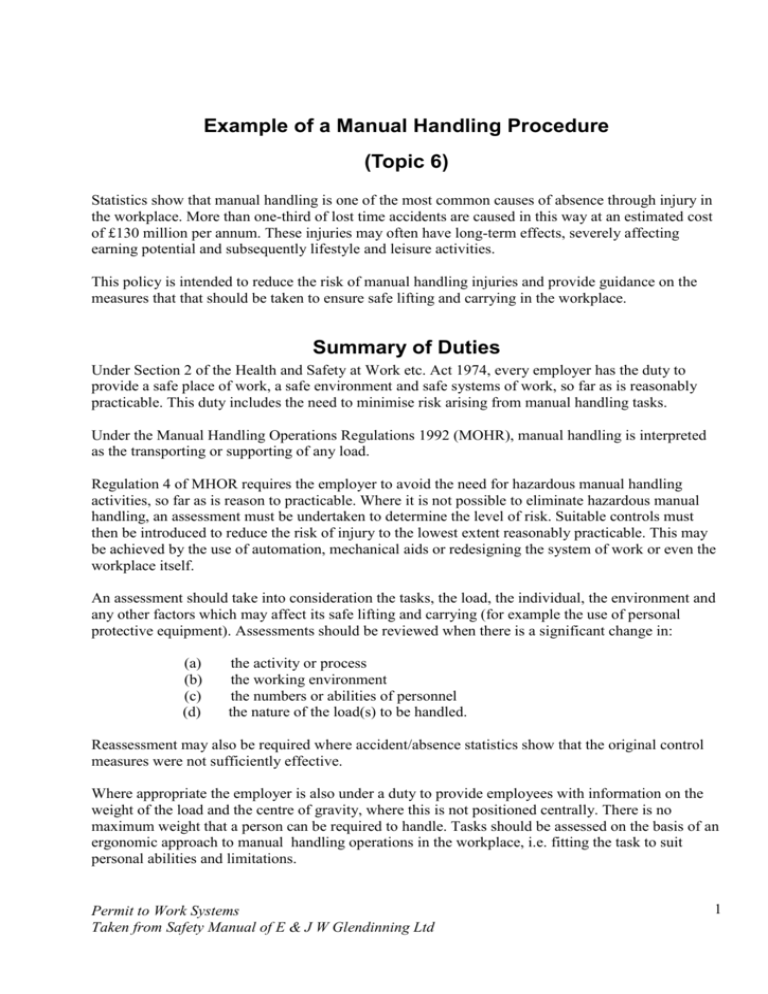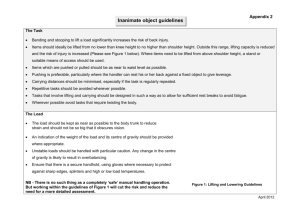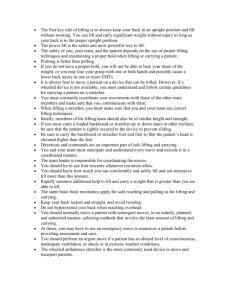Example of a Manual Handling Procedure
advertisement

Example of a Manual Handling Procedure (Topic 6) Statistics show that manual handling is one of the most common causes of absence through injury in the workplace. More than one-third of lost time accidents are caused in this way at an estimated cost of £130 million per annum. These injuries may often have long-term effects, severely affecting earning potential and subsequently lifestyle and leisure activities. This policy is intended to reduce the risk of manual handling injuries and provide guidance on the measures that that should be taken to ensure safe lifting and carrying in the workplace. Summary of Duties Under Section 2 of the Health and Safety at Work etc. Act 1974, every employer has the duty to provide a safe place of work, a safe environment and safe systems of work, so far as is reasonably practicable. This duty includes the need to minimise risk arising from manual handling tasks. Under the Manual Handling Operations Regulations 1992 (MOHR), manual handling is interpreted as the transporting or supporting of any load. Regulation 4 of MHOR requires the employer to avoid the need for hazardous manual handling activities, so far as is reason to practicable. Where it is not possible to eliminate hazardous manual handling, an assessment must be undertaken to determine the level of risk. Suitable controls must then be introduced to reduce the risk of injury to the lowest extent reasonably practicable. This may be achieved by the use of automation, mechanical aids or redesigning the system of work or even the workplace itself. An assessment should take into consideration the tasks, the load, the individual, the environment and any other factors which may affect its safe lifting and carrying (for example the use of personal protective equipment). Assessments should be reviewed when there is a significant change in: (a) (b) (c) (d) the activity or process the working environment the numbers or abilities of personnel the nature of the load(s) to be handled. Reassessment may also be required where accident/absence statistics show that the original control measures were not sufficiently effective. Where appropriate the employer is also under a duty to provide employees with information on the weight of the load and the centre of gravity, where this is not positioned centrally. There is no maximum weight that a person can be required to handle. Tasks should be assessed on the basis of an ergonomic approach to manual handling operations in the workplace, i.e. fitting the task to suit personal abilities and limitations. Permit to Work Systems Taken from Safety Manual of E & J W Glendinning Ltd 1 Section 2 of the Health and Safety at Work etc. Act requires the provision of suitable training, instruction and information. This extends to training in safe methods of lifting and carrying for those employees who undertake manual handling activities.(MHOR) also require appropriate steps to be taken to reduce risk, one of which will be the provision of adequate training. In nearly every job in the company there are a number of lifting operations carried out by staff and operatives. The office worker may need to lift a computer (not an item that is especially heavy, but one which has an awkward shape and prone to having electrical leads dangling around a person's feet), or there is the lifting of the photocopier paper, access to files kept low down or on high shelves. At the other end of the scale would be the workshop fitters handling a heavy piece of plant or surfacing operatives lifting kerbstones. In between there are a multitude of manual handling operations which could give rise to the risk of injury. A number of practical things can be done to reduce the risks of injury from manual handling operations. Arrangements for securing the Health and Safety of Employees The elimination of hazardous manual handling activities: The company will ensure the operations which involve manual handling are eliminated, so far as is reasonably practicable. The measures to achieve this include an ergonomic design of the workplace and activity and the provision of automated or mechanical aids such as trolleys, conveyors or other lifting equipment. Assessment of risk: An assessment of manual handling activities will be carried out by competent persons. Risks which are identified will be reduced the lowest level reasonably practicable. The following factors should be considered during the assessment. The task Bending and stooping to lift a load significantly increases the risk of a back injury. Items should ideally be lifted from no higher than knee-height to no higher than shoulder height. Outside this range, lifting capacity is reduced and the risk of injury is increased. When items are required to be lifted from above shoulder height, a stand or suitable means of access should be used. Items which are pushed or pulled should be as near to waist level as possible. Pushing is preferred, particularly where the back can rest against a fixed object to give leverage. Carrying distances should be minimised, especially if the task is regularly repeated. Repetitive tasks should be avoided whenever possible. Tasks which involves lifting and carrying should be designed in such a way as to allow for significant rest breaks (rotation of tasks) of to avoid fatigue. Avoid tasks which require twisting the body where ever possible. The load The Load should be kept as near as possible to the body trunk to reduce strain and should be not of such size as to obscure vision. An indication of the weight of the load and the centre of gravity should be provided where appropriate. Unstable loads should be handled with particular caution. The change in the centre of gravity is likely to result in over balancing. 2 Permit to Work Systems Taken from Safety Manual of E & J W Glendinning Ltd Ensure there is a secure hand hold, using gloves were necessary to protect against sharp edges or splinters. The individual The consideration must be given to age, body weight and physical fitness. Regard must be given to personal limitation, employees must not attempt to handle those which are beyond thier individual capability. Assistance must be sought where this is necessary. Persons with genuine physical or clinical reasons for avoiding lifting should be made allowance for, as should pregnant women, who should not be required to undertake hazardous lifting or carrying tasks. Significant knowledge and understanding of the work is an important factor in reducing the risk of injury. Individuals undertaking lifting of carrying will be given suitable instruction, training and information to undertake the task with minimum risk. The working environment There must be adequate space to enable the activity to be conducted in safety and the transportation route must be free from obstruction. Lighting, heating and weather conditions must be taken into account. Floors another working services must be in a safe condition, and adequate ventilation is required, particularly where there is no natural ventilation Other factors The use of personal protective equipment may be necessary whilst carrying out manual handling activities. If the use of personal protective equipment restricts safe and easy movement, this should be reported. Constant interruptions from other employees must be avoided, as this can reduce the concentration of an individual. Duties of managers and supervisors Managers or supervisors must ensure and that: manual handling assessments are carried out were relevant and records are kept employees are properly supervised adequate information and training is provided to persons carrying out manual handling activities any injuries or incidents relating to manual handling are investigated, with remedial action taken employees adhere to safe systems of work safety arrangements for manual handling operations are regularly monitored and reviewed employees undertaking manual handling activities are suitably screen for reasons of health and safety, before undertaking the work special arrangements are made, when necessary, for individuals with health conditions who could be adversely affected by manual handling operations Permit to Work Systems Taken from Safety Manual of E & J W Glendinning Ltd 3 Duties of Employees Employees must ensure that: They report to management (in confidence) any personal conditions which may be detrimentally affected by the manual handling activity They comply with instruction and training which has provided in safe manual handling activities Their own health and safety is not put at risk when carrying out manual handling activities They use equipment which has been provided to minimise the risk from manual handling activities Any problems relating to the activities are reported to a responsible person Information and Training Suitable information and training, will be provided to persons who are required to carry out manual handling activities. Training needs will be identified and reviewed by the responsible person. Refresher training will also be given at reasonable intervals. Employees will be informed of the approximate weight of loads which are handled and objects which have eccentric weight distribution. Safe System of Work Poor lifting and carrying techniques can result in discomfort and increase the risk of injury. In extreme circumstances, these injuries can have permanent effects. These risks can be reduced by adopting the following simple precautions: Ensure that formalised systems of work have been designed for the work activity are complied with. Make full and proper use of aids to lifting and carrying, such as trolleys, and lifting equipment Store heavy items between the shoulder and hip height. Where possible only store small, light items above shoulder or below knee height. Use the legs and knees to bend and lift - do not stoop or bend the back. Avoid tasks which require stretching or twisting. Ensure that regular rest breaks are taken where manual handling activities are repetitive to prevent the onset of fatigue. Ensure that there are no sharp, hot or cold edges which could cause injury. Ensure that walkways are free from obstructions. Make full and proper use of personal protective equipment. Report any problems or concerns associated with manual handling operations to a responsible person without delay. Permit to Work Systems Taken from Safety Manual of E & J W Glendinning Ltd 4





